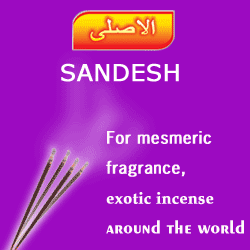|
|
| |
| Padma Perfumery Works Replenish your senses! |
| Rose Incense |
White Musk Incense |
Al Oudh Incense |
Sheik Al Arab Blue |
Jasmine Incense |
|
|
|
|
|
 |
 |
 |
 |
 |
|
|
|
Lily of the Valley Incense Sticks
Synonyms---May Lily. Convallaria. Our Lady's Tears. Convall-lily. Lily Constancy. Ladder-to-Heaven. Jacob's Ladder. Male Lily.

Parts Used---Flowers, leaves, whole herb.
Habitat - Lily of the Valley is largely found in Europe and spread over North America and Northern Asia. In England it is in abundance and considered as a wild flower. It grows mostly in the dryer parts of woods - especially ash woods, often forming extensive patches.
The Lily-of-the-Valley shows a broad leafy structure and of little fragrance. The nodding, white and bell shaped flowers are 5-10 mm in diameter and sweetly scented; flowering is in late spring, in mild winters in the Northern Hemisphere it is in early March. The plant has a small orange red berries that contain a few large whitish to brownish colored seeds.
The growth of the plant starts in early spring days when the creeping rhizome or underground stem grows in small shoots, emerging from a scaly sheath. The plant has two types of leaves; one is plain, oval blades with almost conclave surfaces, and second one is deeply ribbed and slant a little backwards so as to catch rain water. At the back of the leaves, the scaly sheath is enclosed, which is actually the flower stalk, quite bare of leaves itself and bearing at its summit a number of buds, greenish when young and having a very short stalk. The flowers do not have honey but sweet and juicy sap stored around the base of the ovary.
Cultivation Of Lily of the Valley
The plant is easy to cultivate in moist and sandy loam. The plant can last long
Plant towards the end of September. The ground for Lily-of-the-Valley should be thoroughly stirred to a depth of 15 inches, early in September, laying it up rough for a few weeks, t hen breaking it down and adding some rotten manure, or if that cannot be obtained, some kind of artificial manure must be used, but this is better applied later on, hoeing it in just as growth appears. Plant the crowns about 6 inches apart and work fine, rich soil, with some leaf mould if possible, in between. Leave at least 9 inches between the rows. Keep the crowns well below the surface and above all plant firmly. hen breaking it down and adding some rotten manure, or if that cannot be obtained, some kind of artificial manure must be used, but this is better applied later on, hoeing it in just as growth appears. Plant the crowns about 6 inches apart and work fine, rich soil, with some leaf mould if possible, in between. Leave at least 9 inches between the rows. Keep the crowns well below the surface and above all plant firmly.
In some soils the plants will last longer in the best form than in others, but should be transplanted about every fourth year and in light, porous soils it may be necessary to do so every third year. Periodic transplanting, deep culture and liberal feeding produce fine blooms. Autumn is the best time for remaking beds, which are best done in entirely fresh soil. Cut the roots from the old bed out into tufts 6 inches or 9 inches square, and divide into pieces 3 inches square. Replant the tufts the original 6 inches apart. It is best to prepare the entire beds before replanting. Replanted by October, the crowns will be well settled in by winter rains, and the quality of the spikes will show a marked difference in early spring.
Due to their unique fragrance and properties the lily of the valley, they are also used in making incense sticks, incense products and other scented products. Contact us to buy or for more information on lily of the valley incense sticks and other incense products made from lily of the valley.
|
|
|










 hen breaking it down and adding some rotten manure, or if that cannot be obtained, some kind of artificial manure must be used, but this is better applied later on, hoeing it in just as growth appears. Plant the crowns about 6 inches apart and work fine, rich soil, with some leaf mould if possible, in between. Leave at least 9 inches between the rows. Keep the crowns well below the surface and above all plant firmly.
hen breaking it down and adding some rotten manure, or if that cannot be obtained, some kind of artificial manure must be used, but this is better applied later on, hoeing it in just as growth appears. Plant the crowns about 6 inches apart and work fine, rich soil, with some leaf mould if possible, in between. Leave at least 9 inches between the rows. Keep the crowns well below the surface and above all plant firmly.